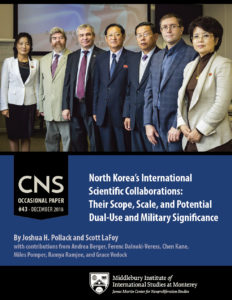December 19, 2018
By Joshua H. Pollack and Scott LaFoy
with contributions from Andrea Berger, Ferenc Dalnoki-Veress, Chen Kane, Miles Pomper, Ramya Ramjee, and Grace Vedock
North Korean leader Kim Jong Un has described research and development as crucial to his regime’s efforts to overcome the international sanctions regime. By developing key technologies indigenously, North Korea seeks to reduce its need to import sensitive goods that might otherwise be denied to it through export controls, sanctions enforcement, or lack of funds. Direct collaboration between North Korean and foreign scientists is playing an expanding role in the regime’s pursuit of technological advancement.
To assess the extent of this activity, and to identify collaborative research involving dual-use technologies and other technologies of potential military significance, the James Martin Center for Nonproliferation Studies (CNS) of the Middlebury Institute of International Studies at Monterey developed a new dataset capturing publications coauthored by North Korean scientists and foreign scientists between 1958 and April 2018.
About 95 percent of the articles in the CNS dataset concern the natural sciences, engineering, computer science, or mathematics, mirroring the general orientation of the North Korean scientific establishment. China is the most heavily represented partner country, followed distantly by Germany.
Based on an initial evaluation, at least 100 published articles jointly authored by North Korean and foreign scientists have identifiable significance for dual-use technology, weapons of mass destruction (WMD), or other military purposes. Areas of concern or potential concern include:
- Uranium purification (Romania, 1991–92)
- Insulation of high-voltage cables for nuclear power plants (China, 2007–12)
- Materials science with a potential nuclear application (China, 2012)
- Damping technology applicable to space/missiles (China, 2016–17)
- Mathematical modeling applicable to space/missiles (China, 2006–16)
- Special heavy vehicles and production systems (China, 2011–16)
- Precision machine tools (China, 2016)
- Carbon composites (China, 2012)
- Other materials science with potential military applications (China, 2011–18)
- Optical tracking and image parsing (China, 2011–16)
- Remote sensing and satellite-imagery processing (China and United States,
2010–13) - GPS-related work (Germany and China, 2007 and 2016)
- Laser and plasmonics research (Germany and China, 1998–2016)
- Biological research potentially of a dual-use character (China and Australia, 1987–2017)
- Cybersecurity (China, 2012)
Some of these activities may be contrary to provisions in international and national sanctions regimes. UN Security Council resolutions forbid the provision to North Korea of “technical training, advice, services, or assistance” related to a list of banned items that includes dual-use and military-related “technology.” The definition of “technical assistance,” for this purpose, includes the transfer of technical data, instruction, skills, training, working knowledge, and consulting services. The sanctions regime may therefore provide leverage against the continuation of some areas of collaborative research.
UN member states must decide what research activities by their nationals or within their territory lie within the scope of sanctions, and which activities are better avoided, even if they are otherwise permissible. The establishment of an agreed set of common principles or guidelines is warranted.
Related Links
- Download the full dataset
- See also NPR’s exclusive look at the report in Geoff Brumfiel and Sean McMinn, “Open Scientific Collaboration May Be Helping North Korea Cheat Nuclear Sanctions,” National Public Radio, December 19, 2018.

